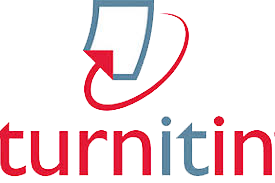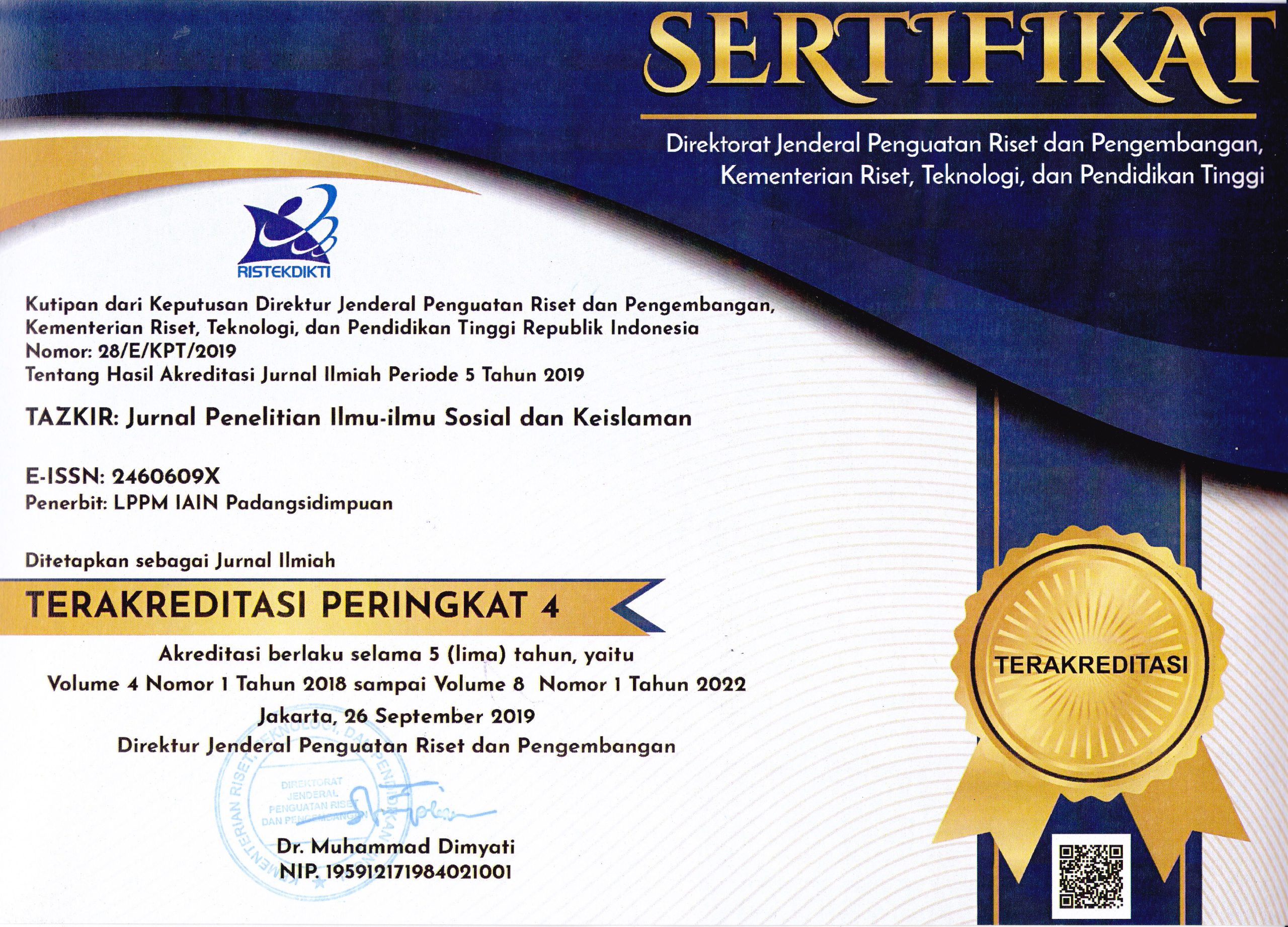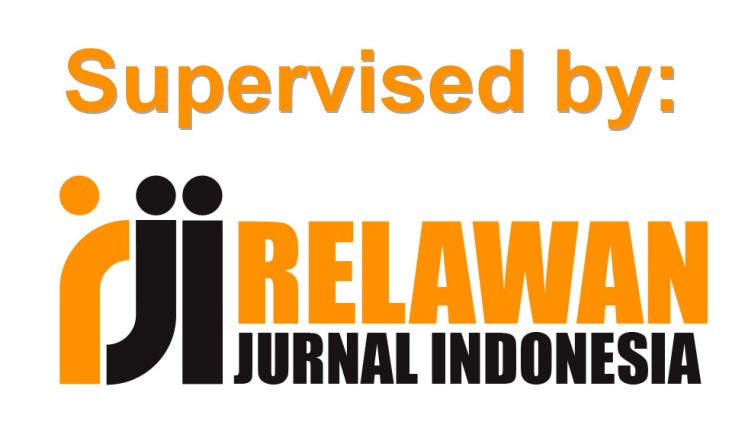Evaluation of UIN North Sumatra E-Learning Program During the Covid-19 Period
Abstract
Keywords
Full Text:
PDF [INDONESIA]References
Al Aslamiyah, T., et.al. (2019). “Blended Learning dan Kemandirian Belajar Mahasiswa Teknologi Pendidikan” Jurnal Kajian Teknologi Pendidikan, 2(2). http://journal2.um.ac.id/index.php/jktp/article/view/7862.
Alonso, F., et.al. (2005). “An Instructional Model for Web-Based E-Learning Education with A Blended Learning Process Approach” British Journal of Educational Technology, 36(2): 217-235. https://doi.org/10.1111/j.1467-8535.2005.00454.x.
Anggrawan, A. (2019). “Analisis Deskriptif Hasil Belajar Pembelajaran Tatap Muka dan Pembelajaran Online Menurut Gaya Belajar Mahasiswa” MATRIK: Jurnal Manajemen, Teknik Informatika dan Rekayasa Komputer, 18(2): 339-346. https://doi.org/10.30812/matrik.v18i2.411.
Arikunto, S., Cepi, S., & Jabar, A. (2014). Evaluasi Program Pendidikan: Pedoman Teoritis Praktis bagi Mahasiswa dan Praktisi Pendidikan. Jakarta: Bumi Aksara.
Asbari, M., et.al. (2020). “Hard Skills dan Soft Skills: Apa Membangun Inovasi Guru Sekolah Islam” Evaluasi: Jurnal Manajemen Pendidikan Islam, 4(1). http://e-journal.staima-alhikam.ac.id/index.php/evaluasi/article/view/362.
Assingkily, M.S., & Miswar, M. (2020). “Urgensitas Pendidikan Akhlak Bagi Anak Usia Dasar (Studi Era Darurat Covid 19)” TAZKIYA, 9(2). http://jurnaltarbiyah.uinsu.ac.id/index.php/tazkiya/article/view/836.
Bell, B.S. & Federman, J.E. (2013). “E-Learning in Postsecondary Education” The Future of Children, 23(1): 165-185. https://www.jstor.org/stable/23409493?seq=1.
Budiman, H. (2017). “Peran Teknologi Informasi dan Komunikasi dalam Pendidikan” Al-Tadzkiyyah: Jurnal Pendidikan Islam, 8(1). http://103.88.229.8/index.php/tadzkiyyah/article/view/2095.
Cerovsek, T. (2011). “A Review and Outlook for a ‘Building Information Model’ (BIM): A Multi-Standpoint Framework for Technological Development” Advanced Engineering Informatics, 25(2): 224-244. https://doi.org/10.1016/j.aei.2010.06.003.
Clark, R.C. & Mayer, R.E. (2008). E-learning and the Science of Instruction. San Francisco: John Willey Son, Inc.
Conole, G. & Oliver, M. (2007). Contemporary Perspectives in E-Learning Research: Themes, Methods and Impact on Practice. USA: Routledge.
Conrad, R.M. & Donaldson, J.A. (2004). Engaging the Online Learner: Activities and Resources for Creative Instruction. USA: Josssey-Bass.
Cucinotta, D. & Vanelli, M. (2020). “WHO Declares Covid-19 a Pandemic” Acta Bio-Medica: Atenei Parmensis, 91(1): 157-160. https://doi.org/10.23750/abm.v91i1.9397.
Darmalaksana, W., et.al. (2020). “Analisis Pembelajaran Online Masa WFH Pandemic Covid-19 sebagai Tantangan Pemimpin Digital Abad 21” Karya Tulis Ilmiah (KTI) masa WFH Covid-19, UIN Sunan Gunung Djati Bandung: 1-12. http://digilib.uinsgd.ac.id/30434/.
Dewi, W.A.F. (2020). “Dampak Covid-19 Terhadap Implementasi Pembelajaran Daring di Sekolah Dasar” Edukatif: Jurnal Ilmu Pendidikan, 2(1). https://edukatif.org/index.php/edukatif/article/view/89.
Dhanapal, S., et.al. (2019). “XYZ Application as a Tool for Teaching and Learning in Institution of Higher Learning: an Exploratory Study”, in Jurnal Pengurusan, Vol. LV. https://ejournal.ukm.my/pengurusan/article/view/25135
Diyana, D.G.H. (2017). “Evaluasi Pemanfaatan E-learning dengan menggunakan Model CSE-UCLA”, in Jurnal Cakrawala Pendidikan, Vol. XXXVI, No. 2. https://journal.uny.ac.id/index.php/cp/article/view/12853
Donnelly, R. & Sweneey, F.M.C. (2010). Applied E-learning and E-teaching in Higher Education. New York: Information Science Reference.
Elihami, E. & Saharuddin, A. (2018). “Peran Teknologi Pembelajaran Islam dalam Organisasi Belajar” Edumaspul: Jurnal Pendidikan, 1(1): 1-8. https://doi.org/10.33487/edumaspul.v1i1.34.
Firman, F. & Rahayu, S. (2020). “Pembelajaran Online di Tengah Pandemi Covid-19” Indonesian Journal of Educational Science, 2(2). https://ojs.unsulbar.ac.id/index.php/ijes/article/view/659.
Fordjour, C.O., et.al. (2020). “The Impact of Covid-19 on Learning-The Perspective of the Ghanaian Student” European Journal of Education Studies, 7(3). https://www.oapub.org/edu/index.php/ejes/article/view/3000.
Garcia, A.C., et.al. (2015). “An Empirical Study on M-Learning Adaptation: Learning Performance and Learning Contexts” Computers & Education, 82(1): 450-459. https://doi.org/10.1016/j.compedu.2014.12.007.
Gunawan, I. (2011). “Evaluasi Program Pembelajaran” Jurnal Pendidikan, 17(1). http://e-journal.unipma.ac.id/index.php/JP/article/view/108.
Guntoro, D., et.al. (2016). “Pengembangan Model Supervisi Akademik Berbantuan E-Supervision Berbasis Web” Educational Management, 5(2). https://journal.unnes.ac.id/sju/index.php/eduman/article/view/12967.
Hamtini, T.M. (2008). “Evaluating e-learning programs: An adaptation of Kirkpatrick's model to accommodate e-learning environments”, in Journal of Computer Science, Vol. IV, No. 8. http://citeseerx.ist.psu.edu/messages/downloadsexceeded.html
Herawati, E. (2011). “Komunikasi dalam Era Teknologi Komunikasi Informasi” Binus University Journal, 2(1). http://202.58.182.161/index.php/Humaniora/article/view/2955.
Ismail, M.D., et.al. (2009). “SMEs’ Export Performance: The Effect of Learning Orientation and Innovativeness”, in Jurnal Pengurusan, Vol. LIV.
Ismail, et.al. (2018). “Pengembangan Kompetensi Mahasiswa Melalui Efektivitas Program Magang Kependidikan” Edumaspul: Jurnal Pendidikan, 2(1): 124-132. https://doi.org/10.33487/edumaspul.v2i1.48.
Iyer, P., et.al. (2020). “Impact of Covid-19 on Dental Education in the United States” Dent Educ, 84(1): 718-722. https://www.immagic.com/eLibrary/ARCHIVES/GENERAL/U_LONDON/L040616L.pdf.
O’Neil, H.F.J. & Farez, R.S. (ed.). (2003). Technologyu Application in Education: A Learning View. Lawrence Erlbaum Associates, inc.
Jamun, Y.M. (2018). “Dampak Teknologi Terhadap Pendidikan” Jurnal Pendidikan dan Kebudayaan Missio, 10(1). http://jurnal.unikastpaulus.ac.id/index.php/jpkm/article/view/54.
Keengwe, J. & Onchwari, G. (2009). “Technology and Early Childhood Education: A Technology Integration Professional Development Model for Practicing Teachers” Early Childhood Education Journal, 37(209). https://doi.org/10.1007/s10643-009-0341-0.
Khan, B. (2005). Managing E-Learning Strategies: Design, Delivery, Implementation and Evaluation. USA: George Washington University.
Kurniadi, D. & Mulyani, A. (2016). “Implementasi Pengembangan Student Information Terminal (S-IT) untuk Pelayanan Akademik Mahasiswa” Jurnal Algoritma, 13(2). https://doi.org/10.33364/algoritma/v.13-2.437.
Kwan, R., et.al. (ed.). (2008). Enhancing Learning Through Technology. New Jersey: World Scientific.
Kwan, R., et.al., (Ed.). (2008). Enhancing Learning Through Technology: Research on Emerging Technologies and Pedagogies. Singapore: World Scientific Publishing.
Laurillard, D. (2004). “E-Learning in Higher Education” From Changing Higher Education, ed. Paul Ashwin. https://www.immagic.com/eLibrary/ARCHIVES/GENERAL/U_LONDON/L040616L.pdf.
Mahmudi, I. (2011). “CIPP: Suatu Model Evaluasi Program Pendidikan” Al-Ta’dib: Journal of Pesantren Education, 6(1). http://dx.doi.org/10.21111/at-tadib.v6i1.551.
Mesiono, M. (2020). “E-Learning Management of the State Islamic University of North Sumatera in Pandemic Covid-19”, in International Journal of Advanced Science and Technology, Vol. XXIX, No. 5.
Miarso, Y.H. (2004). Menyemai Benih Teknologi Pendidikan. Jakarta: Prenada Media.
Middlehurst, R. (2002). “Variations on a Theme: Complexity and Choice in A World Ofborderless Education” Journal of Studies in International Education, 6(2): 134-155. https://doi.org/10.1177%2F1028315302006002004.
Munir. (2009). Pembelajaran Jarak Jauh Berbasis Teknologi Informasi dan Komunikasi. Bandung: Alfabeta.
Muryadi, A.D. (2017). “Model Evaluasi Program dalam Penelitian Evaluasi” Jurnal Ilmiah Penjas (Penelitian, Pendidikan dan Pengajaran), 3(1). http://ejournal.utp.ac.id/index.php/JIP/article/view/538
Mustofa, M.I., et.al. (2019). “Formulasi Model Perkuliahan Daring Sebagai Upaya Menekan Disparitas Kualitas Perguruan Tinggi” Walisongo Journal of Information Technology, 1(2). http://www.journal.walisongo.ac.id/index.php/jit/article/view/4067.
Nasution, Y.R. (2018). “Penerapan Aplikasi Online Angket Persepsi Mahasiswa Terhadap Kinerja Dosen UIN Sumatera Utara Medan” Journal of Islamic Science and Technology, 3(2). http://jurnal.uinsu.ac.id/index.php/jistech/article/view/3158.
Nurdyansyah, N. (2017). “Sumber Daya dalam Teknologi Pendidikan” Disertasi, Sidoarjo: Universitas Muhammadiyah Sidoarjo. http://eprints.umsida.ac.id/1625/.
Petersen, K. (2009). “Ease of Access: Suicide and Prevention” Journal Digital Research & Publishing, 3(2). https://ses.library.usyd.edu.au/bitstream/handle/2123/8130/DRPJournal_5pm_S1_2?sequence=1#page=71.
Piliang, Y.A. (2012). “Masyarakat Informasi dan Digital: Teknologi Informasi dan Perubahan Sosial” Jurnal Sosioteknologi, 11(27). http://journals.itb.ac.id/index.php/sostek/article/view/1098.
Pilkington, A., et.al., (2002). “The Electric Vehicle: Patent Data As Indicators of Technological Development” World Patent Information, 24(1): 5-12. https://doi.org/10.1016/S0172-2190(01)00065-5.
Purwanto, A., et.al. (2020). “Studi Eksploratif Dampak Pandemi Covid-19 Terhadap Proses Pembelajaran Online di Sekolah Dasar” EduPsyCouns: Journal of Education, Psychologi, and Counseling, 2(1): 1-12. https://ummaspul.e-journal.id/Edupsycouns/article/view/397.
Ruhe, V. & Zumbo, B.D. (2009). Evaluation in Distance Education and E-Learning: The Unfolding Model. New York: The Guilford Press.
Garcia, S., et.al. (2020). “Reduction in ST-Segment Elevation Cardiac Catheterization Laboratory Activations in the United States During Covid-19 Pandemic” Journal of the American College of Cardiology. https://www.onlinejacc.org/content/accj/early/2020/04/07/j.jacc.2020.04.011.full.pdf?downloa.
Setemen, K. (2010). “Pengembangan Evaluasi Pembelajaran Online” Jurnal Pendidikan dan Pengajaran, 43(3): 207-214. https://ejournal.undiksha.ac.id/index.php/JPP/article/viewFile/124/118.
Stufflebeam, D.L. & Anthony, J.S. (2007). Evaluations: Theory, Models and Applications. San Fransisco: Jossey-Bass.
Suryadi, S. (2015). “Peranan Perkembangan Teknologi Informasi dan Komunikasi dalam Kegiatan Pembelajaran dan Perkembangan Dunia Pendidikan” Informatika: Jurnal Ilmiah AMIK Labuhanbatu, 3(3). https://jurnal.ulb.ac.id/index.php/informatika/article/view/219
Syafaruddin. (2008). Efektivitas Kebijakan Pendidikan: Konsep, Strategi, dan Aplikasi Kebijakan Menuju Organisasi Sekolah Efektif. Jakarta: Rineka Cipta.
Thombare, D.G. & Verma, S.K. (2008). “Technological Development in the Stirling Cycle Engines” Renewable and Sustainable Energy Reviews, 12(1): 1-38. https://doi.org/10.1016/j.rser.2006.07.001.
Tim Penyusun. (2019). Panduan E-Learning UIN Sumatera Utara. Medan: UIN Sumatera Utara.
Vickery, G. (2012). “Smarter and Greener? Information Technology and the Environment: Positive or Negative Impacts?” International Institute for Sustainable Development. https://www.iisd.org/pdf/2012/com_icts_vickery.pdf.
Wardiana, W. (2002). “Perkembangan Teknologi Informasi di Indonesia” Seminar dan Pameran Teknologi Informasi FT Unikom Bandung Jawa Barat. http://eprints.rclis.org/6534/.
Yang, G., et.al. (2013). “The Effectiveness of Automatic Text Summarization in Mobile Learning Contexts” Computers & Education, 68(1): 233-243. https://doi.org/10.1016/j.compedu.2013.05.012.
DOI: https://doi.org/10.24952/tazkir.v7i2.4540
Refbacks
- There are currently no refbacks.
Copyright (c) 2021 Tazkir : Jurnal Penelitian Ilmu-ilmu Sosial dan Keislaman

This work is licensed under a Creative Commons Attribution-ShareAlike 4.0 International License.

This work is licensed under a Creative Commons Attribution-ShareAlike 4.0 International License.
Editorial Office:
Institute for Research and Community Services; Universitas Islam Negeri Syekh Ali Hasan Ahmad Addary Padangsidimpuan.
Jl. T. Rizal Nurdin Km. 4,5 Sihitang 22733 Padangsidimpuan, Sumatera Utara, Indonesia.
Phone: (+62) 634 22080 Faximili: (+62) 634 24022
e-mail: lppm@uinsyahada.ac.id
 View My Stats
View My Stats



